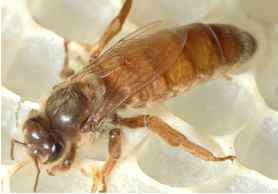Every beekeeper runs into a testy hive once in awhile. Bees can get defensive for a lot of reasons. Most often, it is the beekeepers fault, dropping something, bumping the hive, moving too quickly, disturbing a frame of bees.
The weather can make bees cranky too. If the weather is cool and cloudy, a lot more bees will be at home that day with nothing else to do but defend the hive. This is why it isn’t a good idea to open up a hive when rain is threatening. A poor nectar flow can can have the same effect.
On a sunny day during a good nectar flow, when a hive is opened, the bees should be so absorbed by their work that they barely notice you. That is why, when a beekeeper has a hive that is consistently defensive no matter how good the weather is, something must be done.
In a case like this, the queen has passed down a trait of excessive defensiveness to her young and since all the bees in the hive have hatched from her eggs, they all are defensive. This means a hive that is difficult to work with and potentially hazardous.
So how does a beekeeper change the behavior of this problem hive? By changing the genetics and introducing a new queen. Easier said than done.
The hive in question is on a rooftop in downtown Chicago. It is an extremely successful hive with lots of bees storing lots of honey. Just what a beekeeper likes to see, but very difficult to work on.
In order to introduce the new queen, the hive must be opened up and the old queen must be found and killed. Harsh, yes but necessary.
It is never easy to find a queen in a hive that is many boxes tall and full of bees. The task is extra difficult when there are angry bees flying all around. Lots of smoke is required to confuse and distract them while the search goes on for the soon to be ex-queen. Eventually she was found and executed.
As quickly as possible, the new queen, inside a small screened box called a queen cage, was placed inside the hive. Doing this allows the bees to get used to her pheromone scents and accept her as their new queen. If all goes well, they will release her and she will begin laying eggs.
Worker bees with her genetics will begin to hatch out of their cells 21 days from the day they were laid. At the rate of 1000 to 2000 eggs per day, her takeover will be complete in a matter of weeks.
Can we be certain the hive will be as successful or productive or even less defensive? Not completely.
Photo courtesy of University of Illinois Extension

















